Miele H 326, H 310, H 320, H 316 User Manual
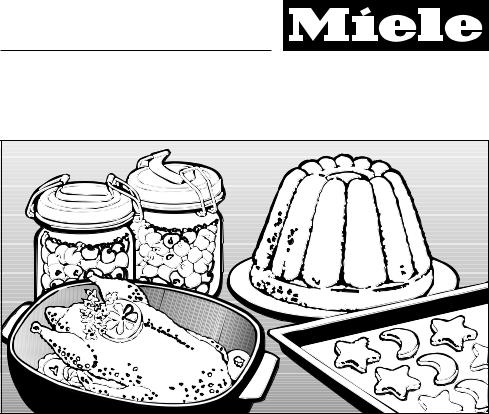
Operating instructions
Ovens and cookers
H 310, H 320
H 316, H 326
It is essential to read these |
Q\} |
operating instructions before |
|
installing or using the machine, |
|
to avoid the risk of accident, |
|
or damage to the machine. |
M.-Nr. 05 389 880 |

Contents
Description of the appliance . . . . . . . . . . . . . . . . . . . . . . . . . . . . . . . . . . . . . . . . . 5 Accessories . . . . . . . . . . . . . . . . . . . . . . . . . . . . . . . . . . . . . . . . . . . . . . . . . . . . . . . 7 Hob . . . . . . . . . . . . . . . . . . . . . . . . . . . . . . . . . . . . . . . . . . . . . . . . . . . . . . . . . . . . . 7
Caring for the environment . . . . . . . . . . . . . . . . . . . . . . . . . . . . . . . . . . . . . . . . . 10
Warning and Safety instructions . . . . . . . . . . . . . . . . . . . . . . . . . . . . . . . . . . . . 11
Before using for the first time. . . . . . . . . . . . . . . . . . . . . . . . . . . . . . . . . . . . . . . 16
Hobs . . . . . . . . . . . . . . . . . . . . . . . . . . . . . . . . . . . . . . . . . . . . . . . . . . . . . . . . . . . 18 Ceramic hobs. . . . . . . . . . . . . . . . . . . . . . . . . . . . . . . . . . . . . . . . . . . . . . . . . . . . . 18 Cooking zones . . . . . . . . . . . . . . . . . . . . . . . . . . . . . . . . . . . . . . . . . . . . . . . . . 18 Residual heat indicator . . . . . . . . . . . . . . . . . . . . . . . . . . . . . . . . . . . . . . . . . . . 18 Extended area. . . . . . . . . . . . . . . . . . . . . . . . . . . . . . . . . . . . . . . . . . . . . . . . . . 18 Enclosed hotplates. . . . . . . . . . . . . . . . . . . . . . . . . . . . . . . . . . . . . . . . . . . . . . . . . 18
Hobs - use. . . . . . . . . . . . . . . . . . . . . . . . . . . . . . . . . . . . . . . . . . . . . . . . . . . . . . . 19 Hob controls. . . . . . . . . . . . . . . . . . . . . . . . . . . . . . . . . . . . . . . . . . . . . . . . . . . . . . 19 Using the hob. . . . . . . . . . . . . . . . . . . . . . . . . . . . . . . . . . . . . . . . . . . . . . . . . . . . . 19 Suggested hob settings . . . . . . . . . . . . . . . . . . . . . . . . . . . . . . . . . . . . . . . . . . 19 Choice of suitable pans . . . . . . . . . . . . . . . . . . . . . . . . . . . . . . . . . . . . . . . . . . . . . 20 Notes on the use on hobs . . . . . . . . . . . . . . . . . . . . . . . . . . . . . . . . . . . . . . . . . . . 21
Description of the systems . . . . . . . . . . . . . . . . . . . . . . . . . . . . . . . . . . . . . . . . . 22
Ovens - use. . . . . . . . . . . . . . . . . . . . . . . . . . . . . . . . . . . . . . . . . . . . . . . . . . . . . . 23 Controls . . . . . . . . . . . . . . . . . . . . . . . . . . . . . . . . . . . . . . . . . . . . . . . . . . . . . . . . . 23 Function selector. . . . . . . . . . . . . . . . . . . . . . . . . . . . . . . . . . . . . . . . . . . . . . . . 23 Temperature selector . . . . . . . . . . . . . . . . . . . . . . . . . . . . . . . . . . . . . . . . . . . . 24 Using the oven . . . . . . . . . . . . . . . . . . . . . . . . . . . . . . . . . . . . . . . . . . . . . . . . . . . . 24 Pre-heating the oven . . . . . . . . . . . . . . . . . . . . . . . . . . . . . . . . . . . . . . . . . . . . . . . 25
Accessories . . . . . . . . . . . . . . . . . . . . . . . . . . . . . . . . . . . . . . . . . . . . . . . . . . . . . 26 Baking tray, grill pan / oven tray and rack . . . . . . . . . . . . . . . . . . . . . . . . . . . . . . . 26 Roasting (grease) filter. . . . . . . . . . . . . . . . . . . . . . . . . . . . . . . . . . . . . . . . . . . . . . 26 Handle . . . . . . . . . . . . . . . . . . . . . . . . . . . . . . . . . . . . . . . . . . . . . . . . . . . . . . . . . . 27 Anti-splash tray . . . . . . . . . . . . . . . . . . . . . . . . . . . . . . . . . . . . . . . . . . . . . . . . . . . 27

Contents
Timer . . . . . . . . . . . . . . . . . . . . . . . . . . . . . . . . . . . . . . . . . . . . . . . . . . . . . . . . . . . 28 Functions . . . . . . . . . . . . . . . . . . . . . . . . . . . . . . . . . . . . . . . . . . . . . . . . . . . . . . . . 28 Push buttons . . . . . . . . . . . . . . . . . . . . . . . . . . . . . . . . . . . . . . . . . . . . . . . . . . . 28 Symbols in the display . . . . . . . . . . . . . . . . . . . . . . . . . . . . . . . . . . . . . . . . . . . 28 Time of day . . . . . . . . . . . . . . . . . . . . . . . . . . . . . . . . . . . . . . . . . . . . . . . . . . . . . . 29 Short time (Minute minder). . . . . . . . . . . . . . . . . . . . . . . . . . . . . . . . . . . . . . . . . . . 29 Programming cooking time automatically . . . . . . . . . . . . . . . . . . . . . . . . . . . . . . . 30 Switch off automatically . . . . . . . . . . . . . . . . . . . . . . . . . . . . . . . . . . . . . . . . . . 30 Delaying the start of cooking time . . . . . . . . . . . . . . . . . . . . . . . . . . . . . . . . . . 30
To check and change an
entered time . . . . . . . . . . . . . . . . . . . . . . . . . . . . . . . . . . . . . . . . . . . . . . . . . . . . . . 31 Cancelling an automatic
process . . . . . . . . . . . . . . . . . . . . . . . . . . . . . . . . . . . . . . . . . . . . . . . . . . . . . . . . . 31 Changing the audible tone. . . . . . . . . . . . . . . . . . . . . . . . . . . . . . . . . . . . . . . . . . . 31
Baking . . . . . . . . . . . . . . . . . . . . . . . . . . . . . . . . . . . . . . . . . . . . . . . . . . . . . . . . . . 32
Baking chart . . . . . . . . . . . . . . . . . . . . . . . . . . . . . . . . . . . . . . . . . . . . . . . . . . . . . 34
Roasting . . . . . . . . . . . . . . . . . . . . . . . . . . . . . . . . . . . . . . . . . . . . . . . . . . . . . . . . 36
Oven roasting chart . . . . . . . . . . . . . . . . . . . . . . . . . . . . . . . . . . . . . . . . . . . . . . . 38
Defrosting . . . . . . . . . . . . . . . . . . . . . . . . . . . . . . . . . . . . . . . . . . . . . . . . . . . . . . . 39
Cooking. . . . . . . . . . . . . . . . . . . . . . . . . . . . . . . . . . . . . . . . . . . . . . . . . . . . . . . . . 40 Casseroles . . . . . . . . . . . . . . . . . . . . . . . . . . . . . . . . . . . . . . . . . . . . . . . . . . . . . . . 40 Cooking ready made meals . . . . . . . . . . . . . . . . . . . . . . . . . . . . . . . . . . . . . . . . . . 41
Grilling. . . . . . . . . . . . . . . . . . . . . . . . . . . . . . . . . . . . . . . . . . . . . . . . . . . . . . . . . . 42
Grill chart . . . . . . . . . . . . . . . . . . . . . . . . . . . . . . . . . . . . . . . . . . . . . . . . . . . . . . . 44
Cleaning and care . . . . . . . . . . . . . . . . . . . . . . . . . . . . . . . . . . . . . . . . . . . . . . . . 45 Ceramic hob surface . . . . . . . . . . . . . . . . . . . . . . . . . . . . . . . . . . . . . . . . . . . . . . . 45 Enclosed hotplates. . . . . . . . . . . . . . . . . . . . . . . . . . . . . . . . . . . . . . . . . . . . . . . . . 47 Appliance front and control panel . . . . . . . . . . . . . . . . . . . . . . . . . . . . . . . . . . . . . 48 Accessories . . . . . . . . . . . . . . . . . . . . . . . . . . . . . . . . . . . . . . . . . . . . . . . . . . . . . . 48

Contents
PerfectClean . . . . . . . . . . . . . . . . . . . . . . . . . . . . . . . . . . . . . . . . . . . . . . . . . . . . . 49 Catalytic enamel surfaces . . . . . . . . . . . . . . . . . . . . . . . . . . . . . . . . . . . . . . . . . . . 51 To remove the oven door . . . . . . . . . . . . . . . . . . . . . . . . . . . . . . . . . . . . . . . . . 53 To re-fit the oven door . . . . . . . . . . . . . . . . . . . . . . . . . . . . . . . . . . . . . . . . . . . . 54 To remove the runners . . . . . . . . . . . . . . . . . . . . . . . . . . . . . . . . . . . . . . . . . . . 54 To remove the back panel. . . . . . . . . . . . . . . . . . . . . . . . . . . . . . . . . . . . . . . . . 56 To lower the upper heating element . . . . . . . . . . . . . . . . . . . . . . . . . . . . . . . . . 57
Correcting minor faults . . . . . . . . . . . . . . . . . . . . . . . . . . . . . . . . . . . . . . . . . . . . 58
After sales service . . . . . . . . . . . . . . . . . . . . . . . . . . . . . . . . . . . . . . . . . . . . . . . . 64
Extra accessories. . . . . . . . . . . . . . . . . . . . . . . . . . . . . . . . . . . . . . . . . . . . . . . . . 65
Electrical connection UK, IRL, ZA . . . . . . . . . . . . . . . . . . . . . . . . . . . . . . . . . . . 66
Installation - Ceramic hobs . . . . . . . . . . . . . . . . . . . . . . . . . . . . . . . . . . . . . . . . . 69 KM 213, KM 215 . . . . . . . . . . . . . . . . . . . . . . . . . . . . . . . . . . . . . . . . . . . . . . . . 70 KM 227, KM 228 . . . . . . . . . . . . . . . . . . . . . . . . . . . . . . . . . . . . . . . . . . . . . . . . 71
Installation - Hobs with enclosed hotplates . . . . . . . . . . . . . . . . . . . . . . . . . . . 73
Installing the cooker . . . . . . . . . . . . . . . . . . . . . . . . . . . . . . . . . . . . . . . . . . . . . . 74
Installing the oven . . . . . . . . . . . . . . . . . . . . . . . . . . . . . . . . . . . . . . . . . . . . . . . . 75
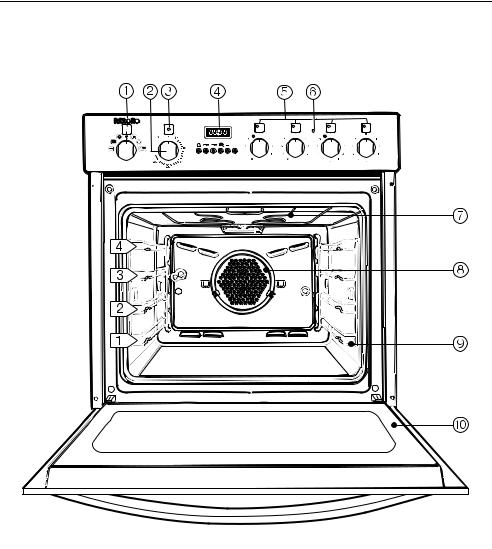
Description of the appliance
General view
"E"-model: cooker with hob controls
Control panel *
b Oven function selector
c Oven temperature selector
d Indicator light for oven heating e Timer *
f Cooking zone controls
g Indicator light for hob cooking areas
Oven interior
hHeating element for top heat and grilling with roof liner
i Air inlet for fan
j Runner heights 1, 2, 3, 4, 5 k Oven door
* depending on model
5
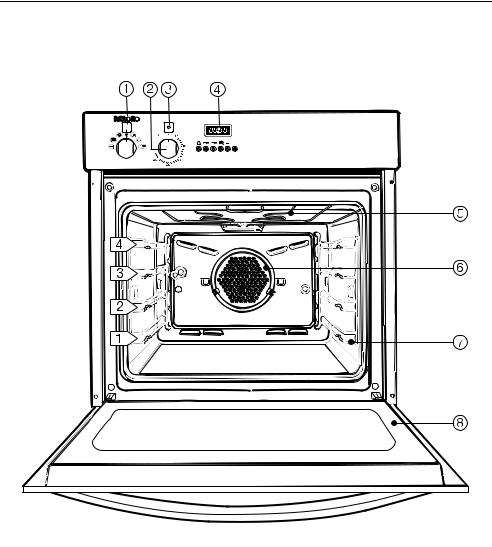
Description of the appliance
"B"-model: oven
Control panel *
b Oven function selector
c Oven temperature selector
d Indicator light for oven heating e Timer*
Oven interior
fHeating element for top heat and grilling
g Air inlet for fan
h Runner heights 1, 2, 3, 4, 5 i Oven door
* depending on model
6

Description of the appliance
Accessories
The following accessories are supplied with this oven:
–baking tray
–dual purpose grill pan / oven tray
–non-tip rack
–a roasting filter
–a handle
–an anti-splash tray
These and other accessories are also available to order from your Dealer or the Miele Spare Parts Department. See “Accessories” and “Extra Accessories” further on in this booklet for more details.
Please note
For "B" model ovens (without hob controls), only the instructions relating to ovens are applicable.
The instructions for hobs relate to "E" model cookers with hob controls, or to the hob of a free-standing cooker.
Hob
The cookers with integrated hob controls can be combined with the following hobs:
KM 200
KM 213, KM 227
KM 215, KM 228
Data plate for hob
A second data plate is supplied with the hob, as the one on the appliance is not visible after installation. Please stick this into the space provided on the "After Sales Service" page of your hob instruction booklet for future reference.
If contacting the Service Department, please quote the model and number of your hob.
7
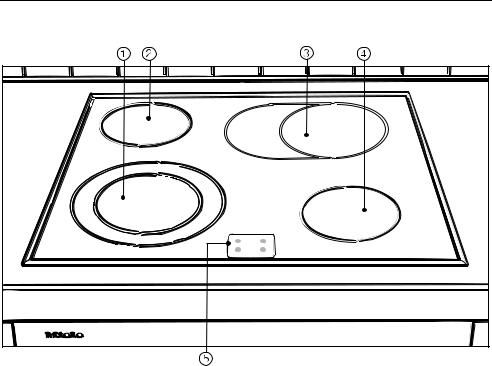
Description of the appliance
Ceramic hob KM 215, KM 228
b Vario cooking zone: 14.5 cm / 21 cm Ø c Cooking zone: 14.5 cm Ø
d Cooking zone / Extended cooking zone: 17 cm Ø / 17 cm x 26 cm * e Cooking zone: 14.5 cm Ø
f Hob display field, residual heat indicator
Ceramic hob KM 213, KM 227
As above except:
* Cooking zone: 18 cm Ø
8
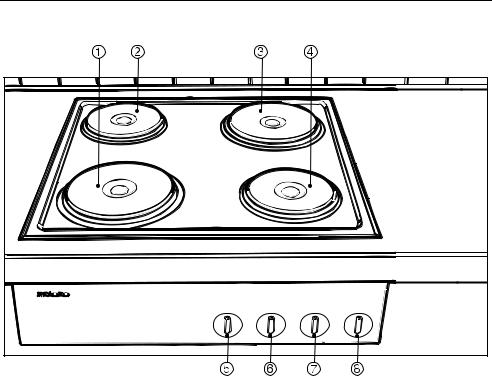
Description of the appliance
Hob with enclosed hotplates KM 200
b Cooking zone: 18 cm Ø c Cooking zone: 14.5 cm Ø d Cooking zone: 18 cm Ø e Cooking zone: 14.5 cm Ø
f Cooking zone control: front left g Cooking zone control: back left h Cooking zone control: back right i Cooking zone control: front right
9

Caring for the environment
Disposal of the packing material
The transport and protective packing has been selected from materials which are environmentally friendly for disposal and can normally be recycled.
Ensure that any plastic wrappings, bags etc. are disposed of safely and kept out of the reach of babies and young children. Danger of suffocation!
Rather than just throwing these materials away, please ensure they are offered for recycling.
Disposal of your old machine
Old machines contain materials which can be reclaimed or recycled. Please contact your dealer, your local waste collection centre or scrap merchant about potential recycling schemes, before disposing of the appliance.
Ensure that the machine presents no danger to children while being stored for disposal. See the appropriate advice in the "Warning and Safety instructions".
10
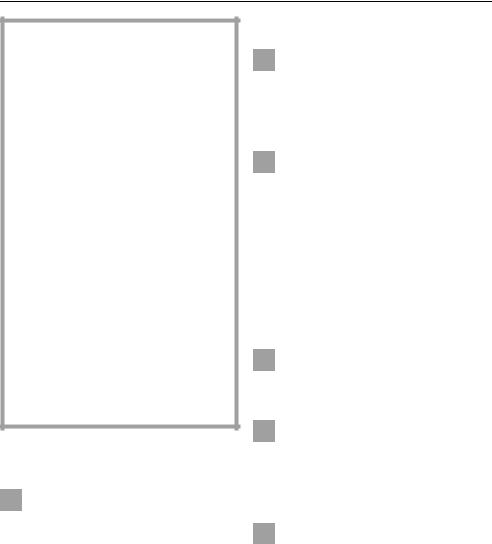
Warning and Safety instructions
This appliance complies with all relevant legal safety requirements. Improper use of the appliance can, however, present a risk of both personal injury and material damage.
Before installation and before using the appliance for the first time, read the operating instructions carefully. They contain important notes on safety, on the installation, operation and care of the appliance. This way you will avoid the risk of accidents and damage to the appliance.
The appliance is not intended for use by young children or infirm persons without supervision.
Young children should be superwised to ensure that they do not play with the appliance.
Keep these instructions in a safe place and pass them on to any future user.
Correct usage
The appliance is intended for domestic use to cook food, and in
particular to bake, roast, defrost, cook, dry fruit etc, and to grill.
Any other usage is at the owner’s risk and could be dangerous. The manufacturer cannot be held responsible for damage caused by improper use of the appliance.
Technical safety
Before connecting the appliance to the mains supply make sure that
the voltage and frequency correspond to the rating on the data plate, otherwise the appliance could be damaged. Consult a competent person if in doubt.
The electrical safety of this appliance can only be guaranteed
when continuity is complete between the appliance and an effective earthing system, which complies with local and national regulations. It is most important that this basic safety requirement is tested by a qualified electrician. The manufacturer cannot be held responsible for the consequences of an inadequate earthing system (e.g. electric shock).
This appliance must only be operated as a built-in appliance. This is
necessary to ensure that all electrical components are shielded.
Never open the casing of the appliance.
Tampering with electrical connections or components and mechanical parts is highly dangerous to the user and can cause operational faults.
Installation work and repairs may only be carried out by a suitably
qualified and competent person in accordance with national and local safety regulations.
Repairs and other work by unqualified persons could be dangerous. The manufacturer cannot be held responsible for unauthorised work.
11
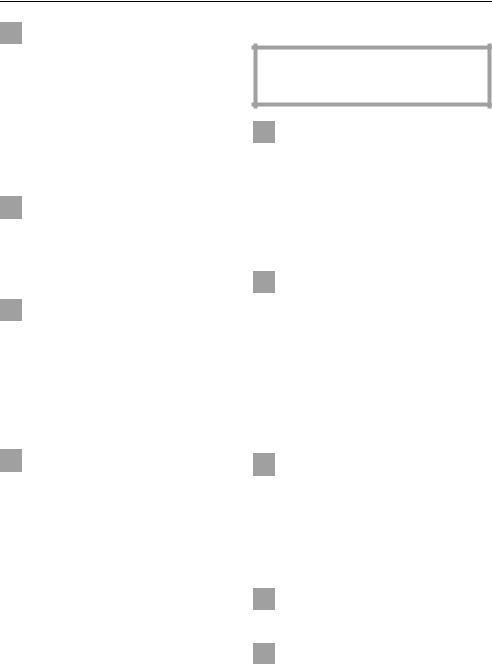
Warning and Safety instructions
The appliance is only completely isolated from the electricity supply
when:
–it is switched off at the wall socket
–or the mains fuse is withdrawn
–or the screw-out fuse is removed (in countries where this is applicable). Ensure that current is not supplied to the appliance while maintenance or repair work is being carried out.
Do not connect the appliance to the mains electricity supply by an
extension lead.
Extension leads do not guarantee the required safety of the appliance, (e.g danger of overheating).
The oven is designed to be built into a tall unit. If you wish to install
it in a base unit, the stainless steel rail above the control panel must be replaced by a sealing strip. The sealing strip offers additional protection from any liquids that might spill down from the worktop, and can be purchased from the Miele Spare Parts dept.
This equipment is not designed for maritime use or for use in mobile in-
stallations such as caravans, aircraft etc. However, it may be suitable for such usage subject to a risk assessment of the installation being carried out by a suitably qualified engineer.
Use
Caution, danger of burning.
High temperatures are produced by the oven and the hob cooking areas.
Great care should be taken to ensure that small children do not
touch the appliance when it is being used. The hob and also external parts of the oven such as the door glass, handle vent and control panel can become quite hot. For cookers with a hob turn pan handles inwards to prevent children from pulling pans over.
Children should not be left alone or unattended in an area where an
oven is in use. They should never be allowed to sit or stand on any part of the oven or play with it.
Do not store items of interest to children in cabinets above an oven. Children climbing on the oven to reach these items could be seriously injured.
Oven
Use of heat-resistant oven gloves is recommended when placing
food in the oven, turning or removing it. When working with "Conventional" heating or when grilling, the element in the roof of the oven and the guard plate become very hot, and there is a danger of being burnt.
Wait until the grill element has cooled down before lowering it for
cleaning, to avoid the danger of burning.
Do not use force to pull it down as this can cause the element to break.
12

Warning and Safety instructions
Do not use plastic containers. These melt at high temperatures
and could damage the oven.
Do not heat up unopened tins or jars of food in the oven, as pressure can
build up and they may explode. This could result in injury or damage.
Do not push pots and pans around on the oven floor as this could
damage the surface.
Do not lean or sit on the open oven door, or place heavy items on it.
This could damage the appliance. Take care in the region of the hinges. The oven door can support a maximum load of 10 kg.
When closing the oven door to prevent the risk of damage hold the
handle firmly and do not let go of it until it is shut. Make sure that nothing gets trapped between the door and the oven.
Cover any food which is left in the oven to be kept hot. This avoids
the food drying out. It also prevents steam condensing and possibly leading to moisture damage in the oven.
Bake any deep-frozen items such as pizzas on baking paper on the
rack itself. Do not place them on the baking tray or in the grill pan/oven tray. This could cause the metal to distort to such an extent that it might be impossible to remove the pan from the oven whilst it is still hot. This distortion would increase with subsequent use. Deep frozen foods such as oven chips or potato croquettes can be cooked on the baking tray or grill pan/oven.
Never add water to food on a hot baking tray or grill pan/oven tray or
directly onto food in a hot oven. The steam created could cause serious burns or scalding and the sudden change in temperature can damage the enamel.
Never line the floor of the oven with aluminium foil when using Conven-
tional top and bottom heat A. Do not place a dish, tin, baking tray or grill pan/oven tray on the floor of the oven.
If using a grill pan/oven tray made by a different manufacturer make sure that there is a gap of at least 6 cm between the bottom of the pan and the floor of the oven.
If these instructions are not observed the bottom heat will be blocked. This can cause permanent damage to the floor of the oven.
Protective aluminium foil panels are available in retail outlets which
are supposed to protect the oven cavity from soiling and reduce the need for cleaning. If used, cooking and baking times will increase considerably.
They can also cause damage to the appliance (e.g. by blocking the heat).
Ceramic hobs
When switched on the cooking areas heat up. A residual heat indi-
cator shows whether a cooking zone is hot.
Do not cover the hob display field by a hot pan. This could cause
damage to the residual heat indicators.
13

Warning and Safety instructions
In the event of any breakages or cracks occurring in the ceramic
hob it must be switched off immediately and disconnected from the electricity supply.
Contact the Service Department.
Do not use the hob until the damaged ceramic plate has been replaced. Continued use would be dangerous as liquids etc. boiling over could penetrate to the electrical components through any crack and cause a short circuit.
Do not use the hob as a resting place for any other objects. This could lead to a danger of the article
catching fire or melting if there is any residual heat or the hob is switched on inadvertently.
Do not use plastic or aluminium foil containers. These melt at high temperatures. Additionally, they could dam-
age a ceramic hob as they melt.
Do not allow either solid or liquid sugar or pieces of plastic or alu-
mium foil to get on to the cooking zones when they are hot. If this is allowed to cool before the hob has been cleaned, the ceramic surface will be susceptible to pitting or even cracking.
Switch the cooking zones off and while the hob is still warm, scrape all the sugar, plastic or aluminium remains from the hob with a shielded blade scraper taking care not to burn yourself.
Do not drop anything on the ceramic hob.
Even a light object such as an egg cup, could cause damage in certain circumstances.
Do not use any pots or pans on the ceramic hob with bases with pro-
nounced edges or ridges, or which are poorly enamelled.
These could scratch or scour the hob surface permanently.
There is a seal between the hob frame and worktop and between the frame and the ceramic plate. Do
not use any sharp pointed object, such as a knife, to clean these seals as they could become damaged.
Hobs with enclosed hotplates
When switched on the cooking areas become hot. Danger of burn-
ing.
Avoid allowing liquids or foods containing salt to spill onto a stainless
steel hob or trim. Should this happen wipe up any spillages containing salt immediately, to avoid corrosion.
Do not use covers on the enclosed hotplates. Turning on the hotplate
with the cover still in place could damage the hotplate. Putting a cover on a damp hotplate could lead to damage of the hotplate. Condensation trapped under the cover could cause corrosion.
Do not use the hob as a resting place for any other objects. This could lead to a danger of the article
catching fire or melting if there is any residual heat or the hob is switched on inadvertently
Do not use plastic or aluminium foil containers. These melt at high temperatures. Additionally they could dam-
age the hob as they melt.
14

Warning and Safety instructions
General notes
Do not leave the appliance unattended when cooking with oils and
fats as these can be a fire hazard if allowed to overheat.
Do not use the oven to heat up the room. Due to the high tempera-
tures radiated, objects left near the oven or hob could catch fire.
Always ensure that food is sufficiently cooked or reheated. Many
factors will affect the overall cooking time, including the size and amount of food, its temperature, changes to the recipe and the shape and size of cooking container. Some foods may contain micro organisms which are only destroyed by thorough cooking at temperatures over 70º C for a minimum of 10 minutes. Therefore when cooking or reheating foods, e.g. poultry, it is particularly important that food is fully cooked through. If in doubt select a longer cooking or reheating time.
It is important that the heat is allowed to spread evenly throughout the food being cooked. This can be achieved by stirring and/or turning the food, and by observing a sufficiently long standing time which should be added to the time needed for cooking, reheating or defrosting.
When using kitchen appliances connected to sockets near the
oven, ensure that the cable cannot come into contact with hot cooking zones or get trapped in a hot oven door, which could melt the cable insulation and be dangerous. Danger of electric shock.
Under no circumstances use a steam cleaner to clean this appliance. The steam could attack the electrical components and cause a
short circuit.
Using alcohol in your recipes: Often alcoholic drinks such as
rum, cognac, wine, etc are used when preparing dishes and oven-cooking them.
The high temperatures can cause the alcohol to vaporise.
Please take note that under adverse circumstances the alcohol can catch light on the hot heating elements.
In countries which may be subject to infestation by cockroaches or
other vermin, pay particular attention to keeping the appliance and its surroundings in a clean condition at all times.
Any damage which might be caused by cockroaches or other vermin will not be covered by the appliance guarantee.
Disposal of your old machine
Before discarding an old machine switch off and disconnect it from
the power supply. This should be done by a competent person. Cut off and render any plug useless.
Cut off the cable directly behind the machine to prevent misuse.
The manufacturer cannot be held liable for damage caused by noncompliance with these Warning and Safety instructions.
15
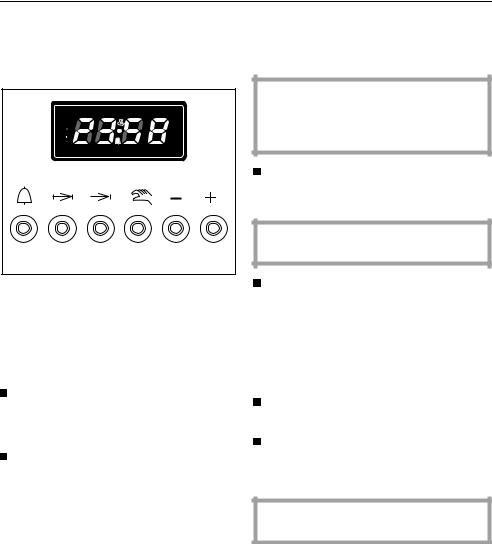
Before using for the first time
Setting the timer
Depending on model, your appliance may be fitted with a timer.
After the appliance has been switched on "0.00" and "AUTO" flash in the display.
Setting the time of day
(24 hour display)
Press and hold buttons "g" and ")" at the same time.
"0·00" and "AUTO" continue to flash.
Enter the time of day in hours and minutes with the + or – button.
Once the time has been entered, the clock advances minute by minute.
Timer-controlled or manual operation
This oven can be operated with timer control - see section "Timer", or manually. Press "i" to allow you to operate the oven manually.
The "@" symbol will appear in the display, indicating that the oven can be used without the timer.
Cleaning the appliance
Oven interior
If there are any stickers on the floor of the oven, baking trays, oven/grill pan etc. these must be removed before use.
Wipe out the oven interior using warm water and a little washing-up liquid. Polish dry with a soft cloth.
Do not close the oven door until the oven interior is dry.
Rinse the accessories.
New appliances have a slight smell on first use. Running the oven for at least an hour at a high temperature will dissipate this more quickly.
Turn the oven function selector to "Fan Heat D".
Select the highest temperature.
Depending on the model the timer can also be used to set the finish time.
Ensure the room is well ventilated during this process.
16

Before using for the first time
Ceramic hob
Thoroughly clean the ceramic hob before first use, then clean regularly after use when just warm to the touch, or cold (see the section on "Cleaning and care").
On first use the hob may give off a slight smell as moisture in the insulation evaporates.
Enclosed hotplates
For the first few times of using a smell will occur.
Heat the hotplates for about
5 minutes at the highest setting. Do not place a pan on them.
The protective coating which prevents the build-up of rust will smoke slightly as it hardens.
Ensure the room is well ventilated during this process.
17
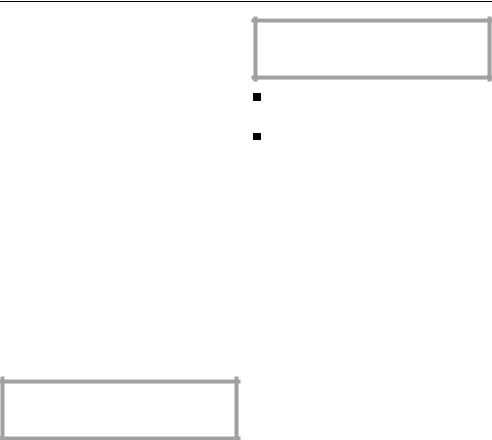
Hobs
Ceramic hobs
Cooking zones
The cooking zones are clearly marked on the hob. Only the zone that is switched on heats up. The surround remains relatively cool.
Residual heat indicator
There is a display field with a residual heat indicator for each zone.
Once the zone is switched on, the indicator light comes on when a certain temperature is reached.
Do not cover the hob display field by a hot pan. This could cause damage to the residual heat indicators.
After switching off, the residual heat indicator light stays on as long as the cooking zone remains hot.
Do not touch these cooking zones or place any heat sensitive objects on them. Danger of burning.
Extended area
Only applicable to hobs with vario or extended cooking zones.
The relevant cooking zone control is also used to switch on the vario / extended area.
Turn the control in a clockwise direction until a resistance is felt. Otherwise the control can be damaged.
Turn the control in a clockwise direction only to the symbol "n".
Then select the setting required.
Turning the zone control back to "0" switches off:
–the cooking zone, and
–the extended area.
Enclosed hotplates
On hobs with enclosed hotplates, there are two different sizes and performance levels of hotplate.
18

Hobs - use
Hob controls
The controls for the cooking zones / hotplates regulate the heat output.
Only turn the controls in a clockwise direction until a resistance is felt, and back again.
Turning them in the other direction will damage them.
When a control is turned to a setting, the hob indicator light comes on. It goes out when all hob zone controls are turned off.
Using the hob
Choose a high setting number for boiling/frying.
Switch to a lower setting to continue cooking, when steam is visible at the rim of the lid.
Switching to a lower setting at the right time:
–avoids pans boiling over,
–food sticking,
–and saves electricity.
Suggested hob settings
|
Setting |
Melting butter, |
|
Chocolate |
|
Dissolving gelatine |
1 |
Preparing junket and yoghurt |
|
Keeping food warm |
|
Warming small quantitites of |
|
food/liquid |
1 – 2 |
Thickening sauces containing |
|
egg yolk, butter |
|
Omelettes |
|
|
|
Defrosting deep frozen items |
|
Cooking rice, pasta, |
|
porridge, |
|
Steaming fruit, vegetables, |
2 – 3 |
Cooking broths, pulse soups |
|
Braising meat, fish, |
|
vegetables |
|
Cooking dumplings, potatoes, |
3 – 5 |
soups |
|
Preparing jams, jellies, stewed |
|
fruit |
|
|
|
Frying chops, liver, sausage, fish, |
|
eggs |
5 – 7 |
|
|
Frying pancakes, dropped |
|
scones and |
|
other liquid batters |
6 – 9 |
Frying steaks
Deep frying (chips, fritters)
Boiling water
These figures, which envisage approx. 4 helpings, should only be taken as a guide. With deep pans, large quantities, or without the lid on, a higher setting is needed. With smaller quantities select a lower setting.
19
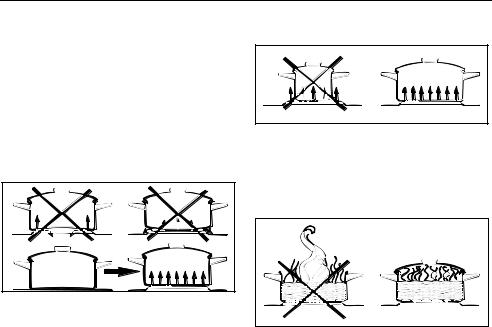
Hobs - use
Choice of suitable pans
Attention to correct choice and use of pans
–will help you obtain the best cooking result most economically,
–and generally avoid food boiling over and sticking.
Pan bases
For maximum economy of electricity when cooking or frying, only use pans with a flat or very slightly concave base. When hot the pan will rest evenly on the hob. Modern saucepans for electric cookers are the most suitable and efficient for use on ceramic cooking zones, or solid hotplates.
Size of pan
The diameter of the saucepan or frying pan should be very slightly larger than that of the hotplate/cooking area.
Pan lids
Cooking with the lid on the pan retains the heat.
20
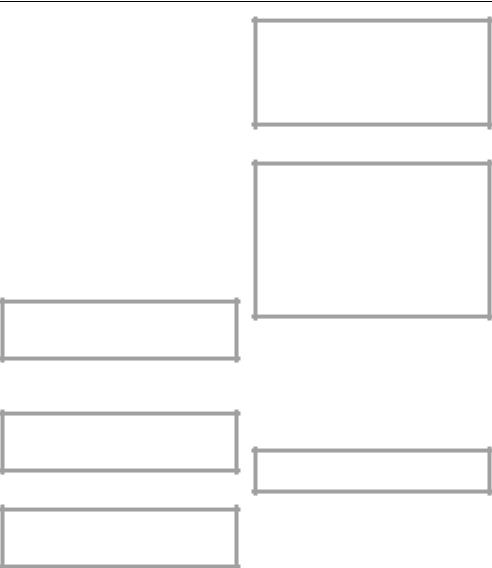
Hobs - use
Notes on the use on hobs
(both ceramic and enclosed hotplates)
Before switching on, place a saucepan containing water or food to be cooked on the hotplate or cooking area. This prevents unnecessary use of energy or the hotplates warping or burning themselves out.
Before starting to cook, make sure that the hotplates or cooking areas and the base of saucepan are clean and dry.
This saves extra cleaning later on.
Additional notes for ceramic hobs
Take care before starting to cook that there is no grit or sand on the surface of the hob.
This would scratch the surface, especially if a pan was pushed across.
Do not use any pots or pans where the base has ridges, a pronounced edge or is poorly enamelled.
These could also cause scratches.
Do not push roasting tins or baking trays etc across the ceramic surface. Scratches could occur.
Aluminium or stainless steel pans with aluminium bases can leave marks with a metallic sheen on the ceramic surface. Clean these away at the earliest opportunity, (see Section on Cleaning and Care).
Never leave boiled-over sugar or syrups, plastic items or aluminium foil on the hob. If this does happen, switch the cooking zones off and while the hob is still warm scrape the sugar, plastic and aluminium remians from the hob with a shielded scraper blade, taking care not to burn yourself.
If these residues are allowed to cool before the hob surface has been cleaned, the ceramic surface will be susceptible to pitting or even cracking.
Additional notes for enclosed hotplates
Do not lay anything wet or damp across the hotplates.
If this does however happen, wipe the hotplate clean and switch on briefly to dry. This is necessary to avoid corrosion.
21

Description of the systems
Fan Heat D
This system works by the circulation of heated air.
A fan situated on the back wall of the oven sucks in the air, heats it over a ring element and blows the heated air through the carefully spaced openings in the rear panel of the oven, enabling lower temperatures to be used than with the Conventional heating system.
The oven does not usually need to be pre-heated as the heated air reaches the food straight away.
Exception: Pre-heating may be necessary for foods such as puff pastry and yeast mixtures where instant heat is required to make them rise quickly.
Using the fan heating system you can bake and roast on different levels at the same time.
Rapid heat-up Ä
With Rapid heat-up the grill element, the bottom heat element and the fan all switch on at the same time so that the oven reaches the required temperature as quickly as possible. The indicator light above the temperature selector goes out when the required temperature has been reached. The oven function selector must then be turned to the function you wish to use.
Conventional heating A
With the conventional method of heating, radiant heat is directed onto the food from above and below. It is useful where a fairly long cooking time is required and a deep colour and good rise are needed.
It is usually necessary to pre-heat the oven for about 20 minutes when using this method.
Grill n
The inner part of the upper heating element acts as the grill. This will glow red a few minutes after switching it on and is then ready for use.
Pre-heat the grill for at least 5 minutes with the oven door closed, before placing food under the grill.
Fan grill N
The hot air from the grill is distributed over the food by the fan on the rear wall of the oven. This enables a lower temperature to be selected than for conventional grilling.
22
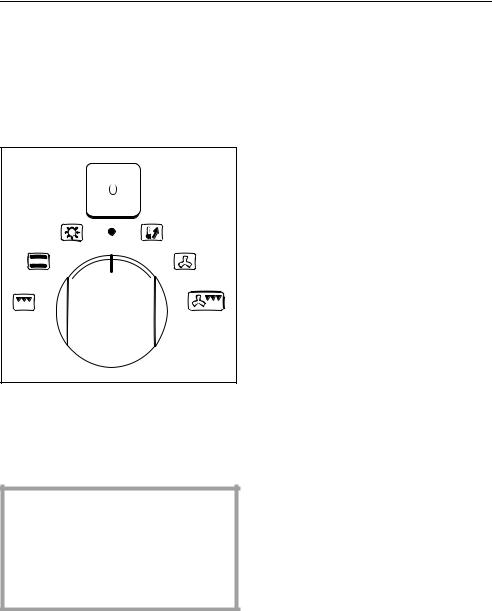
Ovens - use
Controls
There is an oven function selector and a temperature selector.
Function selector
Turn the function selector
–clockwise, to select "Rapid heatup Ä", "Fan heat D" or "Fan
grill N".
–anti-clockwise, to select "Light H", "Conventional A" and "Grill n".
Turn the function selector clockwise only as far as the "Fan grill N" setting or anti-clockwise only as far as the "Grill n" setting. Do not attempt to turn it all the way round in either direction. Do not force it, this would damage the selector.
–Light H
Turns on the oven light independently.
–Conventional A
Top and bottom heat for baking / roasting traditional recipes, for fruit cake.
–Grill n
For grilling fish and cuts such as chops, steaks, poultry pieces, and kebabs.
Grill with the oven door closed.
–Rapid heat-up Ä
For reducing the heating up time and for pre-heating the oven.
Also useful for cooking ready made meals.
–Fan heat D
For baking or roasting on several levels at the same time.
–Fan Grill N
Ideal for grilling thicker items such as stuffed meat, kebabs and pieces of poultry etc. Grill with the oven door closed.
23
